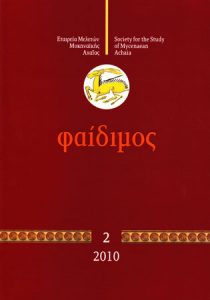ARTICLES | 2010
Radiocarbon dating results for the Early Upper Paleolithic of Klissoura Cave 1
Eurasian Prehistory 7:2 (2010): 37-46.
This chapter reports on 29 radiocarbon dates from Middle and Upper Paleolithic layers at Klissoura 1 Cave. All but two of the dates were obtained from material identified as wood charcoal. Both standard ABA and more stringent ABOX pre-treatment protocols were used for charcoal samples. The radiocarbon dates from the Aurignacian of layers Ille-g and IV show general stratigraphic consistency, and fit with published ages from other Aurignacian assemblages in the Balkans.Geology, stratigraphy, and site formation processes of the Upper Palaeolithic and later sequence in Klissoura Cave 1
Eurasian Prehistory 7:2 (2010): 15-36.
Klissoura Cave 1 is located in the northeastern edge of the Argive Plain, Peloponnese, at the entrance of the Berbadiotis river gorge. The cave comprises a collapsed cave chamber and a rockshelter area. The stratigraphic analysis and micromorphological study of the sediments elucidated the main processes involved in the formation of the site and its depositional history.Klissoura cave 1, Argolid, Greece. Introduction: History of the excavations
Eurasian Prehistory 7:2 (2010): 5-14.
The excavation at Klissoura was planned in 1992, as a joint-project between the Ephoreia of Palaeoanthropology and Speleology of the Ministry of Culture of Greece and the Institute of Archaeology of the Jagiellonian University of Krakow, Poland. Our primary goal was to investigate the circumstances under which the neolithisation of NW Peloponnese came about.Μυκηναϊκό νεκροταφείο Μιτόπολης Αχαΐας (Mycenaean Cemetery of Mitopolis in Achaia)
Patras

Prehistoric Pottery from Lofkënd, Albania: From Bronze to Iron Age in the Balkans
Aegeo-Balkan Prehistory, online article, 17 February 2010
The Lofkënd burial tumulus in the Mallakaster region of Albania was jointly excavated by a team from the Cotsen Institute of Archaeology (CIOA) at UCLA and the Albanian Institute of Archaeology in Tiranë over four seasons (2004-2007), with a fifth season (2008) devoted to study.Mochlos IIB: Period IV. The Mycenaean Settlement and Cemetery: The Pottery
Philadelphia Pennsylvania

Review of the website: Archaeological Atlas of the Aegean
CSA Newsletter, April 2010, Issue-volume XXIII, No. 1.
Vianello, A., 2010. Review of the website ‘Archaeological Atlas of the Aegean’, CSA Newsletter, April 2010, Issue-volume XXIII, No. 1.
Review of the website: Kommos Excavation
CSA Newsletter, September 2010, Issue-volume XXIII, No. 2
Vianello, A., 2010. Review of the website ‘Kommos Excavation, Crete Combining publication media to achieve better results’, CSA Newsletter, September 2010, Issue-volume XXIII, No. 2.
Localising Pylian religion: Thoughts on the geographic references in the Fr tablets provoked by a new quasi-join
Pasiphae IV (2010): 199-215.
Αn autopsy of several Pylian Linear B tablets at the Prehistoric Collection of the National Archaeological Museum at Athens undertaken by the author in April and July 2008 resulted — inter alia — in the identification of a quasi-join between PY Fr 343+1213 and Fr 1209.Nomi Micenei in -QO-RO
Pasiphae IV (2010): 195-197.
Ènoto che -qo-ro corrisponde a –πολος dalla radice indoeuropea *q*ol- che présenta l’apofonia qualitativa di *qwel-, cfr. πέλομαι (v. DELG, s. v.). Ι composti nominali in - πολος sono molto numerosi. Il problema è stato analizzato da vari studiosi.Il valore del segno metrico *112 = T a Tebe e a Pilo
Pasiphae IV (2010): 135-194.
La tavoletta TH Ft 140 présenta una somma da cui risulta che il sottomultiplo t del sistema / délie misure di capacità per arïdi ha il valore, rispetto all’unità di misura, di 1/12 e non di 1/10 come precedentemente definito in base a dati statistici.Pasiphae vol. IV
Pisa/Roma

